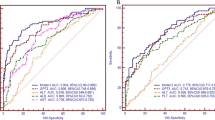Abstract
Golgi protein-73 (GP73) is a newly identified candidate serum marker for HCC, but GP73 study now is lesser in Asian population. The aims of this study were to determine how GP73 is detected in the serum of healthy, hepatitis B, cirrhosis and HCC by western blotting and RT-PCR, and to establish the sensitivity and specificity of serum GP73 protein and RNA for diagnosing HCC. Serum GP73 was detected by western blotting and RT-PCR, and quantified by densitometric analysis. GP73 was measured in serum from 124 patients with various forms of liver. AFP was tested using commercially available electrochemiluminescence immunoassay. The median sGP73 in patients with HBV-related HCC was significantly higher (P < 0.001) than in healthy individuals and in patients with other diseases. When sGP73 protein was used to detect HBV-related HCC, it had a sensitivity of 77.4% and a specificity of 83.9%, at the optimal cut-off value of 7.4 relative units. The area under the receiver–operating characteristic curve was 0.89. GP73 RNA in patients with HBV-related HCC had a sensitivity of 87.1% and a specificity of 83.9% and AUROC of 0.92. AFP in patients with HCC had a sensitivity of 48.4% and a specificity of 96.8% and AUROC of 0.77. GP73 protein and RNA can be found in the serum of patients with HBV-related HCC obviously higher than of other liver diseases in Asian. GP73 was better than AFP for the diagnosis of HBV-related HCC. RT-PCR is a more sensitive and superior method of quantification than Western blot. Furthermore, our data need to be confirmed in larger cohorts of patients.





Similar content being viewed by others
References
Parkin DM, Bray F, Ferlay J, Pisani P. Global cancer statistics 2002. CA Cancer J Clin. 2005;55:74–108. doi:10.3322/canjclin.55.2.74.
Sangiovanni A, Del Ninno E, Fasani P, De Fazio C, Ronchi G, Romeo R, et al. Increased survival of cirrhotic patients with a hepatocellular carcinoma detected during surveillance. Gastroenterology. 2004;126:1005–14. doi:10.1053/j.gastro.2003.12.049.
Llovet JM, Burroughs A, Bruix J. Hepatocellular carcinoma. Lancet. 2003;362:1907–17. doi:10.1016/S0140-6736(03)14964-1.
Marrero JA, Lok AS. Newer markers for hepatocellular carcinoma. Gastroenterology. 2004;127(Suppl 51):S113–9. doi:10.1053/j.gastro.2004.09.024.
Bruix J, Sherman M, Llovet JM, Beaugrand M, Lencioni R, Burroughs AK, et al. Clinical management on hepatocellular carcinoma. Conclusions of the Barcelona-2000 EASL conference. J Hepatol. 2001;35:421–30. doi:10.1016/S0168-8278(01)00130-1.
Collier J, Sherman M. Screening for hepatocellular carcinoma. Hepatology. 1998;27:273–8. doi:10.1002/hep.510270140.
Okuda K. Early recognition of hepatocellular carcinoma. Hepatology. 1986;6:729–38. doi:10.1002/hep.1840060432.
Sherman M. Alphafetoprotein: an obituary. J Hepatol. 2001;34:603–5. doi:10.1016/S0168-8278(01)00025-3.
Bruix J, Sherman M. Management of hepatocellular carcinoma. Hepatology. 2005;42:1208–36. doi:10.1002/hep.20933.
Kladney RD, Bulla GA, Guo L, et al. GP73, a novel Golgi-localized protein upregulated by viral infection. Gene. 2000;249:53–65. doi:10.1016/S0378-1119(00)00136-0.
Maitra A, Thuluvath PJ. GP73 and liver disease: a (Golgi) complex enigma. Am J Gastroenterol. 2004;99:1096–8. doi:10.1111/j.1572-0241.2004.40410.x.
Marrero JA, Romano PR, Nikolaeva O, et al. GP73, a resident Golgi glycoprotein, is a novel serum marker for hepatocellular carcinoma. J Hepatol. 2005;43:1007–12. doi:10.1016/j.jhep.2005.05.028.
Schwegler EE, Cazares L, Steel LF, et al. SELDI-TOF MS profiling of serum for detection of the progression of chronic hepatitis C to hepatocellular carcinoma. Hepatology. 2005;41:634–42. doi:10.1002/hep.20577.
Iftikhar R, Kladney RD, Havlioglu N, et al. Disease- and cell-specific expression of GP73 in human liver disease. Am J Gastroenterol. 2004;99:1087–95. doi:10.1111/j.1572-0241.2004.30572.x.
Kladney RD, Cui X, Bulla GA, Brunt EM, Fimmel CJ. Expression of GP73, a resident Golgi membrane protein, in viral and nonviral liver disease. Hepatology. 2002;35:1431–40. doi:10.1053/jhep.2002.32525.
Kladney RD, Tollefson AE, Wold WS, Fimmel CJ. Upregulation of the Golgi protein GP73 by adenovirus infection requires the E1A CtBP interaction domain. Virology. 2002;301:236–46. doi:10.1006/viro.2002.1523.
Chinese Society of Hepatology. 2004 Guidelines for surgical treatment of primary hepatocellular carcinoma. Zhonghua Gan Zang Bing Za Zhi. 2005;13:329–30.
Chinese Society of Infectious Diseases. The guidelines of prevention and treatment for chronic hepatitis B. Zhonghua Gan Zang Bing Za Zhi. 2005;13:881–91.
Chinese Medical Association. Guideline of prevention and treatment of hepatitis C. Zhonghua Yu Fang Yi Xue Za Zhi. 2004;38:210–5.
Metz CEhB, Shen JH. Maximum-likelihood estimation of receiver operating characteristic (ROC) curves from continuously distributed data. Stat Med. 1998;17:1033–53. doi:10.1002/(SICI)1097-0258(19980515)17:9<1033::AID-SIM784>3.0.CO;2-Z.
Cassandra Willyard. Researchers look for ‘aweet’ method to diagnose cancer. Nat Med. 2007;13:1267. doi:10.1038/nm1107-1267.
Bachert C, Fimmel C, Linstedt AD. Endosomal trafficking and proprotein convertase cleavage of cis golgi protein GP73 produces marker for hepatocellular carcinoma. Traffic. 2007;8:1415–23. doi:10.1111/j.1600-0854.2007.00621.x.
Lorinda MW, Sheri Y, Maria MP. Decreased survival and hepato-renal pathology in mice with C-terminally truncated GP73 (GOLPH2). Int J Clin Exp Pathol. 2009;2:34–47.
Author information
Authors and Affiliations
Corresponding author
Rights and permissions
About this article
Cite this article
Hu, Js., Wu, Dw., Liang, S. et al. GP73, a resident Golgi glycoprotein, is sensibility and specificity for hepatocellular carcinoma of diagnosis in a hepatitis B-endemic Asian population. Med Oncol 27, 339–345 (2010). https://doi.org/10.1007/s12032-009-9215-y
Received:
Accepted:
Published:
Issue Date:
DOI: https://doi.org/10.1007/s12032-009-9215-y




